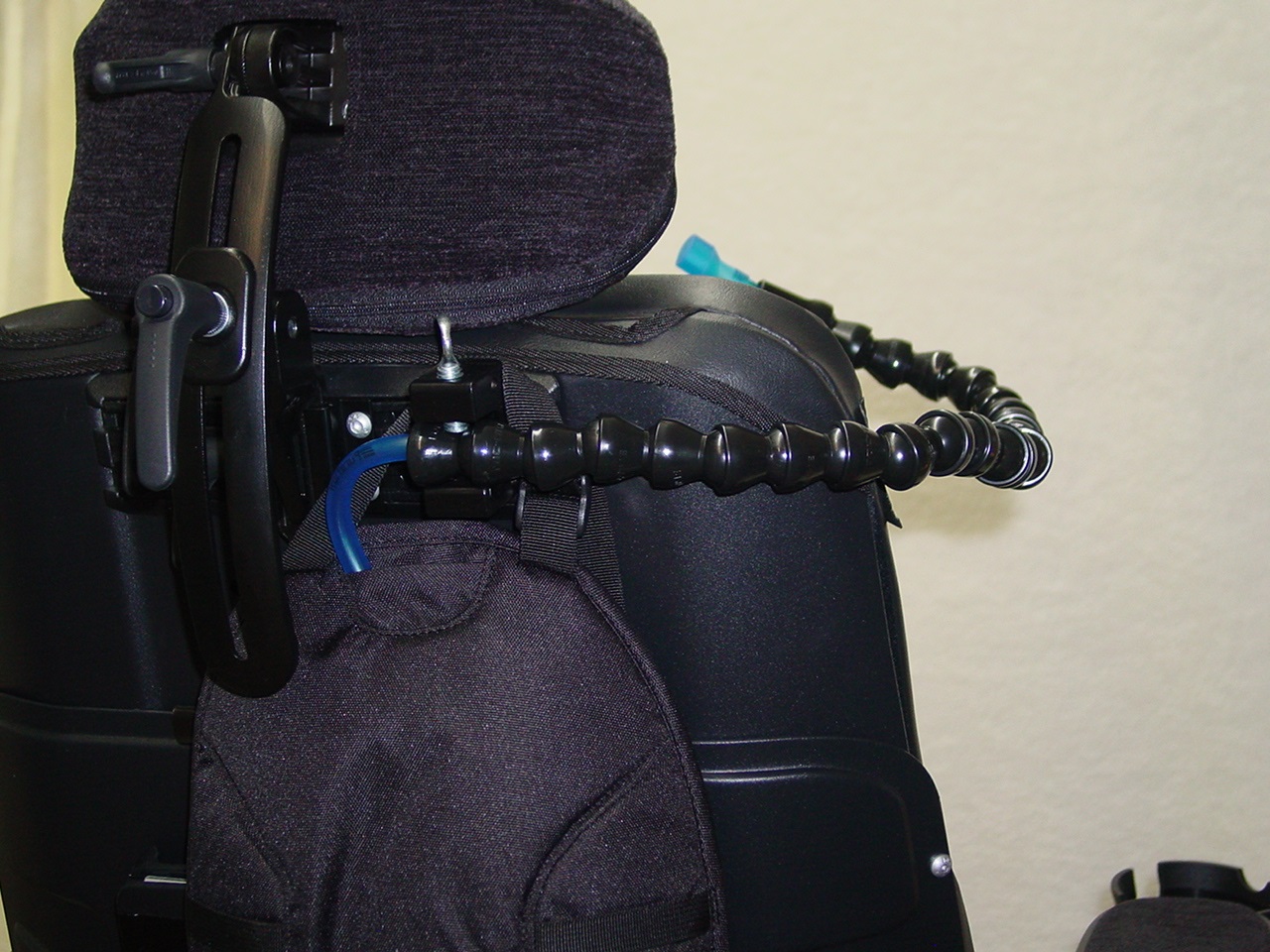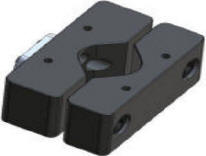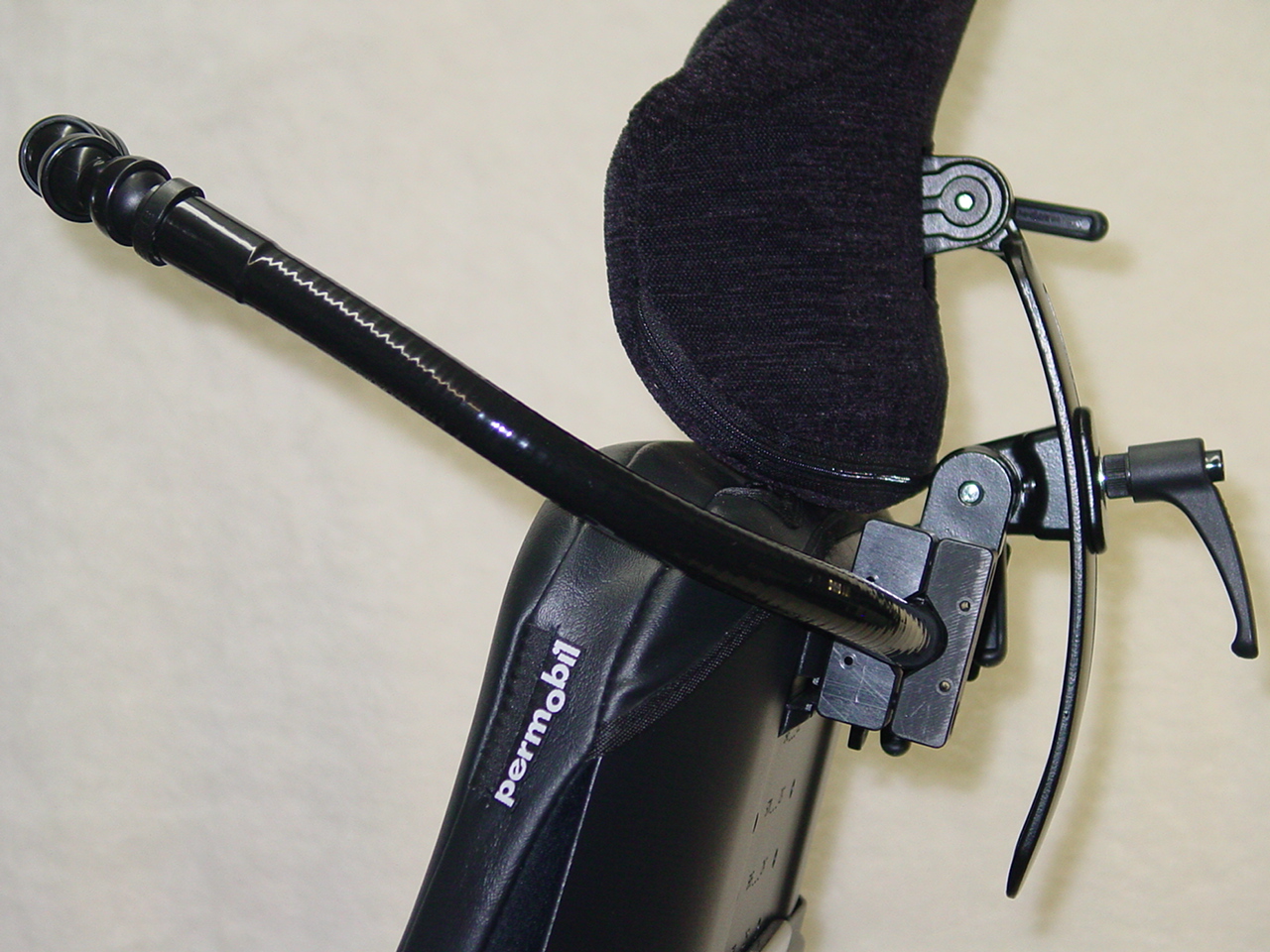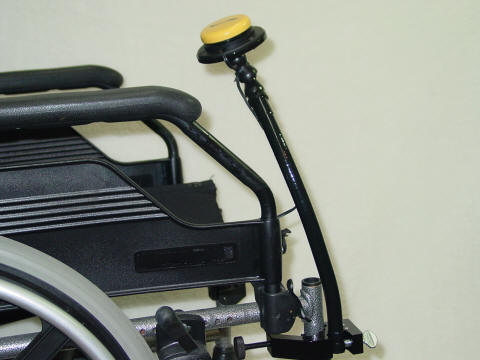Mealtime Partners, Inc.
Specializing in Assistive Dining and Drinking Equipment
February 2016 Independent Eating and Drinking Newsletter

|
February Topics:
|
||
|
Mealtime Partners Home Page Send a Comment or Suggestion |
|||
| Subscribe to Newsletters |
Adaptive Switch Placement for Eating
The majority of powered dining devices are controlled by adaptive switches. Most provide a specific switch with the device that must be used to operate the device. This limits who can use the specific device to those who are able to actuate the provided switch. This requirement greatly limits who can use the equipment. To avoid this constraint, the Mealtime Partner Dining System was designed to be operated by any commercially available adaptive switches. Thus, each person can use the most appropriate switches for them.
In addition to this flexibility, the Mealtime Partner Dining System can be controlled by the user using two, one or no Adaptive Switches. Having two switches empowers the user to control all of the device actions, from selecting which bowl they will eat out of (i.e., food selection), to when they will take each bite of food. It would seem that everyone would want to operate the device in this way wouldn’t it? But what if you fatigue easily? Or, what if you burn too many calories operating switches? In those situations, a compromise should be reached by using fewer switches. The Mealtime Partner allows for a variety of configurations. The user can’t access their choice of food quite as quickly using one switch or without using any switches, nevertheless, with this versatile device you still have the ability to select what and when you eat. (The device uses a special spoon touch sensor that determines if the food is touched, to replace the switches that have been removed.) The method can be changed at any time simply by turning the device off, plugging in one or two switches, or not plugging any switches into the device, and turning the device on again. (The device determines the switch configuration at turn-on.) Being able to change the number of switches is valuable because individuals who have a changing level of function can have the device changed to meet their current need whether it be improving or worsening.
Because there are many different types of adaptive switches, it is important that the most appropriate switches are selected for each individual. Many assistive technology specialists and/or occupational therapists can evaluate which adaptive switches are most appropriate for a user, what body part they should use to activate them, and how the switches should be mounted. Adaptive switches allow people who have physical and/or intellectual disabilities to significantly increase their control over their entire world. Once someone is able to operate adaptive switches, they are able to control a large array of different equipment. With the activation of a switch, lights can be turned on or off; the door can be opened or closed; the phone answered; email sent and received; etc.
Adaptive switches come in a wide variety of designs. The most common adaptive switches require physical contact with the switch to cause activation of whatever the switch is plugged into. When the switch is pressed, electrical contact is made; when the switch is released, the electrical contact is broken. This is just like how a light switch in a house turns lights on or off. The differences within the various contact-type adaptive switches that are commercially available are: their physical external size; the amount of force required to activate the switch; whether the switch produces a sound when it is activated that provides auditory feedback to the user; and whether the surface of the switch is textured to provide tactile feedback to the user (covered with sandpaper or a fabric, etc.).
Regardless of the adaptive switches chosen for an individual, their location and position for operation is very significant. Most individuals who have acquired a disability intuitively want to operate switches with their hands. However, in many cases the hands are not the most reliable body part to press switches repeatedly. For many people finding a reliable body location for switch activation is a challenge. Further difficulties exist with mounting a chosen switch in the desired location and accurately maintaining that position over time.
Locating switches to operate a dining device requires that additional considerations be taken into account. The goal of using a powered dining system is to eat the appropriate calories to sustain health and well-being, safely. If a significant amount of energy is required to activate a switch, a substantial number of calories are burned each time the switch is pressed. Therefore it is important to locate switches close to a body part such that it requires little effort to trigger. Hands, elbows, knees, and feet should all be considered when looking for an appropriate switch location. If no location can produce a repeatable movement without significant effort, a location on the head should be considered.
Activating a switch with your head is a common practice for many different functions including wheelchair operation, and computer access. It is easy to assume that if someone can operate a switch that is located on a headrest, that the same switch can be used to access a dining system. Head position should be considered prior to making this decision. Using any part of the head that requires lifting the chin to activate a switch is unwise because lifting the chin before or during taking food into your mouth can be unsafe. The upward movement of the chin elongates the throat and makes the windpipe more vulnerable to food or liquid entering the airway rather than being directed, as it should be, into the esophagus. The result of material entering the windpipe is choking or aspiration. (More detailed information about the specifics of a chin tuck can be found at the following link: Promoting a Chin Tuck for Safer Eating.)
Lifting the chin upward to activate a switch or moving the head from side to side a significant amount to activate a switch should be avoided. Moving the head sideways by either tilting the neck or rotating it (i.e., moving the chin from side to side), moves the mouth out of midline. Midline describes an imaginary line drawn down the middle of the body from head to toes. Having the mouth at midline is the desirable position for the mouth to be in to take a bite of food.
With this information in mind, specific points on the face are good locations to activate a switch. The temples can safely press a switch without displacing the mouth. The switch should be positioned in front of the temple, not to the side. In this way, the switch can be triggered by a slight forward and downward tilt of the head. The same strategy can be used with a switch that is positioned to be triggered using the cheekbone.
Selecting the best adaptive switch and positioning it accurately can be the difference between someone comfortably feeding themselves, or struggling to do so. Mealtime Partners staff is always available to help with choosing the best dining system for each individual. They can be reached by calling 800-996-8607 or emailing us at info@mealtimepartners.com.
Article 2, below, describes some Mealtime Partners Adaptive Switch Mounting Systems that we have developed to fill needs that are not otherwise available.
|
The Hydration Backpack with Drinking Tube
Positioning for Slide-Track (Part No. 6557) |
| For those of you who were unable to use our Hydration Backpack with Drinking Tube Positioning because it wouldn’t mount on your wheelchair, Mealtime Partners introduces the Hydration Backpack with Drinking Tube Positioning for UniTrack. All of the features that you have enjoyed with the original Hydration Backpack with Drinking Tube positioning, now has a mounting system that can be attached to the UniTrack rail of many powered wheelchairs made by Permobil. |

|
| Easy to install and remove from the wheelchair to fill or clean. |
|
|
| Hands-free drinking, 70 fluid ounces of water available for people on the go! |
|
For more information about this product or to order, click here, or call us at 800-996-8607. |
Mealtime Partners Adaptive Switch Mounting Systems
Because mounting adaptive switches in the most desirable position for each user is so important for reliable and repeatable switch activation, Mealtime Partners has developed mounting systems that allow switches to easily be positioned, or repositioned, at a variety of locations on both powered and manual wheelchairs, and hospital bed rails. Figure 1 illustrates the mounting system with the flex arm bent to locate the switch close to the user’s head.
|
|
| Figure 1: Micro Light Switch Mounted for Head Control |
The Mealtime Partners Flex Arm Mounting Systems are comprised of a clamping system, a Flex Arm, and a "ball and socket" end section, as pictured in Figure 2. The Flex Arm and end section come fully assembled. The Flex Arm is heavy-duty and when bent into the desired shape, will hold the position firmly. The short ball and socket end section is not quite as heavy-duty as the Flex Arm but it permits further bending and swiveling that permits “fine tuning” the final switch position as shown in Figure 3. However, once it is positioned, it is rigid enough to hold it's position and is unlikely to be accidentally repositioned.

| C:\Users\carte\Documents\2018 - Active Files\Website\2018 Websites\2018-10_(October)_MtP-Website (2018-11-01)\Newsletters\2016\02_february\_vti_cnf\flex-arm-mounting_system_end_section.jpg
| Figure 2: Flex Arm and Ball and Socket Assembly Used in Flex Arm Mounting Systems |
|
|
|
| Figure 3: Ball and Socket Assembly Swivel and Bend Capabilities | |
Mealtime Partners provides five different length Flex Arm Mounting Systems for mounting Adaptive Switches, or other user-provided devices, to wheelchairs, tables, bedrails or other fixed objects with appropriate surfaces. Also, a variety of Mounting Plates are available to attach Micro Light Switches, Jelly Bean Switches, and Mini Cup or Specs Switches to the Flex Arm Mounting Systems or Flex Arm Mounting Systems for Slide-Track. Two clamps are available for mounting these assemblies to the wheelchair: the wheelchair clamp (Figure 4); and the Flex Arm Holder for UniTrack (Figure 5).
|
|

|
| Figure 4: The Mealtime Partner Wheelchair
Clamp (Part No. 4960) |
Figure 5: Flex Arm Holder for UniTrack (Part No. 4970) |
The wheelchair clamp (Figure 4, above), allows the Flex Arm Mounting System to be attached to the handles, the frame, or other tubular parts of a wheelchair. It can be oriented in any direction, vertically, horizontally, or on angled parts of the wheelchair frame. It will attach to tubular components ranging from 3/8" to 1 1/4". Although designed specifically for wheelchairs, it can be used to clamp onto any piece of furniture or object with tubes or shafts (like metal bed rails) with the diameters described above. It will also clamp to tables (i.e., flat surfaces) up to 1 3/4" thick.
The Flex Arm Holder for UniTrack, shown in Figure 5, allows the Flex Arm Mounting System to be attached to Permobil wheelchairs that have UniTrack. UniTrack is a dual-slot rail that is used for mounting parts and accessories on many Permobil wheelchairs. Common UniTrack locations include the sides of the seat base, under the armrests and on the wheelchair back. Some of the UniTrack rails have end pieces that fit into the ends of the rails to provide a smooth end to the rails. The end pieces can be removed by pulling them out for installing accessories.
The Flex Arm Holder for UniTrack that is supplied with a Flex Arm Mounting Systems is installed on the wheelchair using the hex key that is provided. This clamp is used for more permanent installations like adaptive switches that do not require regular removal from the wheelchair. It can be mounted vertically, as shown in Figure 6, or horizontally on UniTrack rails using either of the slots in the rails. This allows positioning of the Flex Arm in the most appropriate location for the application. Once it is installed, that tool is unnecessary. However, another tool (i.e., a hex key) is provided for installing the outer clamp body that holds the Flex Arm and must be used to insert of remove the Flex Arm.

|
| Figure 6: Flex Arm Mounting System with 18-Inch Flex Arm for UniTrack (Part No. 5133) mounted on the Back of a Permobil Wheelchair |
Figures 7 and 8 show how the same Switch Mount can be mounted on different types of wheelchairs because compatible Clamps are available: the Wheelchair Clamp (Figure 7), and the Flex Arm Holder for UniTrack (Figure 8).

|
| Figure 7: A Jelly Bean Switch Mounted mounted on a Manual Wheelchair using a Flex Arm Mounting System with 18-Inch Flex Arm (Part No. 5118) |

|
| Figure 8: A Jelly Bean Switch Mounted on a Powered Wheelchair Using a Flex Arm Mounting System with 12-Inch Flex Arm for UniTrack (Part No. 5132) |
All of Mealtime Partners mounting products can be found at either "Mealtime Partners Mounting Products", or "Mealtime Partners Mounting Products for UniTrack". If you need assistance in selected the most appropriate mounting system for your application please call 800-996-8607, or email us at info@mealtimepartners.com.
|
Did You Know?
Did you know that milk that is made from plants like almond,
coconut, or rice milk is not appropriate as a sole source of
food for infants. In many cases, infants who are not breast
fed have difficulties with allergic reactions, or problems
with digestion, with some infant formulas. To remove the
offending product from the infant’s diet is fitting,
however, replacing it solely with a plant based milk, not
specifically developed for feeding infants, is unwise. Babies should ingest at least 50 milligrams of vitamin C every day which, if they are breast fed, will be received through their mother’s milk. If they exclusively drink plant based milk for an extended time they may not intake enough vitamin C. The result of this shortage can be scurvy. Scurvy in infants causes a decrease in appetite, poor weight gain, diarrhea, high temperature and pain in their legs. If left untreated, bones may fracture. Sailors used to develop scurvy after months at sea without foods that provided vitamin C. Once it was understood, ships stocked barrels of citrus fruit for long journeys and scurvy was no longer a problem. |
Mealtime Partners Website Navigation:
Home | Dining | Drinking | Videos | All Products | Ordering | Calendar | FAQ | Newsletters | Contact
Please send comments and suggestions to newsletters@mealtimepartners.com
Copyright © Mealtime Partners, Inc. 2016
All rights reserved.